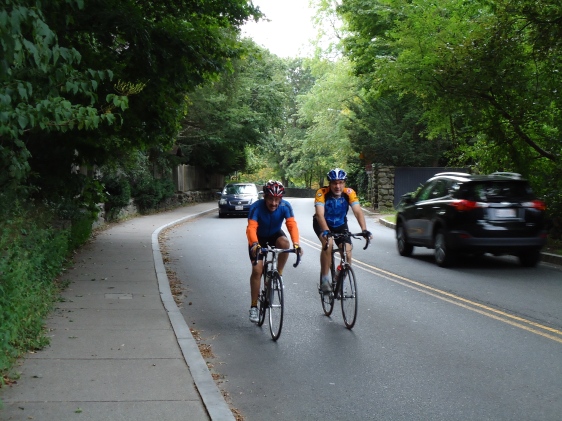
It may seem as if the title of this post says it all, but there is more to this story than meets the eye. We’ve all seen cyclists riding two or more abreast. Riding two abreast is legal in Massachusetts, but is it wise?
I asked myself this question as I walked down a suburban road, where I often ride myself, and saw two older men riding two abreast with a car coming up behind them. It was early on a weekday morning, just at the start of rush hour.
While many people were hurrying to work, these two appeared to be out on a recreational ride. I watched them chatting as they rode along, oblivious to the car behind them. I wondered why they didn’t glance back to see how close the car was getting (at one point it was dangerously close to their rear wheels) or pull over to let the car pass.
In the morning, that road always has quite a bit of traffic. It connects two major roads, both of which lead both to Boston and to the West of the city. There are colleges on either end of it. And on this particular day, the students had already returned to Boston from their summer break. So why the leisurely ride?
There is no way to know for sure, but perhaps their approach was governed by the belief that this was their neighborhood and that they were entitled to take a recreational ride whether others were rushing to work or school. This, of course, was pure conjecture on my part. But, still, they looked very fresh, as if they had just gotten out on the road, so they couldn’t have been riding very long.
If this was the case, they may have had a valid point. Cars travel through residential areas, where the motorists do not live, all the time. They are only there because they are headed somewhere. They are merely passing through.
The residents, on the other hand, live there. It is their home, their neighborhood. Maybe, in a sense, we could call it their turf. Anyone trespassing on it would have to play by their rules.
I wouldn’t blame a cyclist or pedestrian for feeling this way. Many neighborhoods are overrun by cars. Situated in places drivers find convenient, such areas can become gridlocked just when locals want to move around and go about their daily business.
To some, it might appear as if cyclists riding two abreast on a narrow suburban road are inconveniencing drivers who are using the same travel lane. To others, it may look as if the cyclists are asserting their right to keep their neighborhood a place where one can bike and walk without being hurried off the road by outsiders who are in a hurry to cut through the neighborhood.
Whose rights take precedence here? Do the residents of a given area have a right to make drivers wait behind them while they go out for their morning bike ride? Or do drivers have a right to travel the speed limit, regardless of where they are?
I would say that the answer is: people have a right to the peaceful enjoyment of their homes and this would include the ability to utilize their neighborhoods for their normal daily activities. A speed limit would not supersede this right.
My guess is that the driver behind the two cyclists, in the photo at the top of this post, saw it otherwise. He kept inching up on the two cyclists, who ignored him. When his tailgating didn’t get the cyclists to move over, he would hang back and wait.
One complication to all of this exists: what happens when the drivers are residents? Whose rights take precedence then?
One group wants to enjoy the outdoors or simply use an alternative means to travel, and the other group is leaving home to go somewhere. I would like to say that a residential area is not a place which should prioritize cars over humans.
A home is a place where someone takes shelter and finds comfort. So, the human element should take precedence over the mechanical element.
This is not to say that people in a residential area should not cooperate. They should. Each group ought to be aware of the interests and rights of others. At times, those interests will conflict, and it is up to everyone involved to find a way to peacefully coexist.
If I were one of the two guys in the photo, I would continue to take the lane, riding side-by-side, until I reached a stop sign a short distance up the road. At that stop sign, I would fall into single file to give the car room to pass.
Other cyclists may not agree with me; they will have to use their own judgment. Still, whatever they decide, they should consider the long-term ramifications of putting absolute rights above common courtesy and how doing so will affect the image of cyclists.
Everything in life is a trade-off. Everything is a balancing act. Each cyclist must decide for him or herself when to stand firm and when to concede, when to take the lane, and when to pull to the right. Riding a bicycle in traffic consists of a series of judgment calls. And, good judgment can mean the difference between life and death and peace and conflict. Still, we’re all human, and despite our best efforts, variation in judgment and behavior will always exist — to the delight of some and to the chagrin of others.
[Note: Please leave comments on the new blog.]


